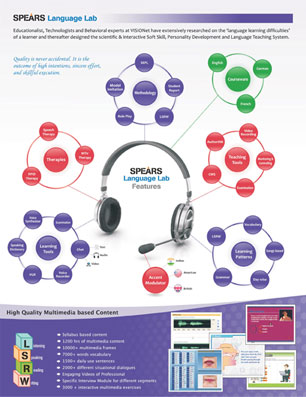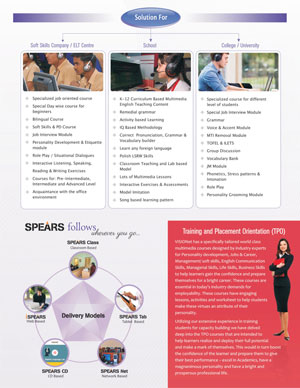Importance of learning English Language
English becomes the default option for communication as it is spoken and understood across the global. Hence making it a good companion for travel enthusiasts. While proficient English-speaking skills appeals your resume and it can boost hiring potential. A recent survey by LinkedIn stated that CEOs and HR Directors prefer English speaking employees over other languages.
“Change your language and you change your thoughts."
English is not the first language for many Indians and it’s a language ought to be learned. It is only taught in a few English medium schools across the country; hence, a huge chunk of population never got the opportunity to learn English language.
Learn English with ease through Digital English Language Laboratory
Language laboratory are based on similar concept of science laboratories where a person can learn how to use the equipment and tools available to get a hands-on experience. They are digital spaces where one can learn and practice language. The idea of Language laboratory dates back to early 19th century. A device called phonograph was used to deliver audio. From the 1950s to the 1990s, most labs used tape-based systems. Currently, language labs generally contain multimedia PCs. Digital language labs are software that can be easily installed on the computer system or it can be accessed by any networked PC from any location.
How Digital English Language laboratory can help your learning process?
- First and foremost, as it is a digital platform, it is available to everyone and can be easily accessed from any location. Hence reaching a wider range of audience.
- To learn a language, one needs constant practice. This software works for the overall development of the learner and enhances the ability to Listen, Speak, Read and Write.
- It provides with digital tools designed exclusively according to the needs of English learners.
- It allows the teacher to monitor the activities of the student, thus, teacher is the controlling authority and can guide the students. The teacher can conduct online tests and generate reports.
- It allows full control over the course structure. One can create, organize and manage content according to their own convenience.
- An in-built voice recording feature is available for exercise and text.
- Notice board facility is provided in the software where all important notifications are grouped in together and alerts the learner about his/her progress.
- Batch Management system allows the learner to choose their own batch.
Also Read Know:
AICTE is the regulatory body governing the higher educational institutions in India. AICTE has supported the introduction of digital language lab in Education institutions. The language labs are used as language tutorials and are attended by students who voluntarily opt for the classes. English language labs benefit the students who are lacking confidence in English speaking. The lab sessions include word games, fun quizzes, extemporary speaking, debates etc. The course also aims at preparing the students for personal interviews and competitive examinations.
Setting up a digital English language laboratory
A number of parameters are to be kept in mind before setting of a digital language lab.
- Hardware requirements – Hardware and infrastructure are the most expensive component for establishing a digital language lab. It takes up most of the budget. However, the cost may be reduced with collaboration of any existing computer lab of an institution.
- Software – Few software such as Words Worth are compatible with both Linux and Microsoft. Linux is a free Operating system and meets the requirements to run the software. An after sales technical support becomes a necessity as the content is being delivered in digital platform. This should be available to ensure a smooth and uninterrupted delivery of the course.
- Human resource - A teacher is necessary in making teaching and learning experience effective. Language is a skill and the blended methodology of computer-based sessions and teacher’s guidance would be most effective.
The teacher is responsible for effective delivery of the content, therefore, support material in form of trainer manual and other guidelines should be available to the teacher.
LSRW Activities for benefits of the Students / Learners
LSWR expands to Listen, Speak, Read, and Write. LSWR is considered the most effective methodology for learning languages. Access to advanced material in text, audio and video formats develop highly effective listening, speaking, reading and writing skills. Writing is a slower communication process, where a person has enough time to frame words and express themselves, while speaking is a simultaneous process. The fear of speaking wrong English and causing embarrassment inhibits people from speaking at all. Digital language lab provides the solution to this problem and teaches you in a sequential manner so that you improve your skills faster and accurately. Language labs make it possible to quickly and efficiently introduce your students to American, English, Irish, Australian, Scottish and various other types of accents they’re likely to encounter out in the world. The lessons can be reviewed in all three formats of text, audio and video, hence, providing quicker learning. The alert option for clarification session with the teacher at one click encourages easy learning for shy students.
Read Know:
Why incorporate Language labs in schools?
A teacher teaches a class of around 40 students in a 45-minute-long period. Each student gets very less time to practice speaking in one class. While the teacher is burdened with finishing a large syllabus in short time, she is unable to provide with the needs of each child.
With Language labs, all students in the class can speak and practice simultaneously without distracting each other regardless of the class size. Language lab gives an opportunity to work on individual needs, which is difficult to be achieved in a classroom setting.
Similar is the example of CBSE tying up with Trinity College, London for the ASL Project to test speaking and listening skills of the learners in classes IX and XI. However, the project only involved few components of a language lab.
A school meets the hardware, software and human resource requirements to set up a digital language lab. The school’s computer lab can be integrated a language laboratory. Inclusion of LSRW will make learning English more interactive and fun for the students. Content will be available as pictures, sound, texts and video and the teachers can adjust materials to fit the necessity of the students. The teachers will also have the authority to track the performance of each student time-to-time.


